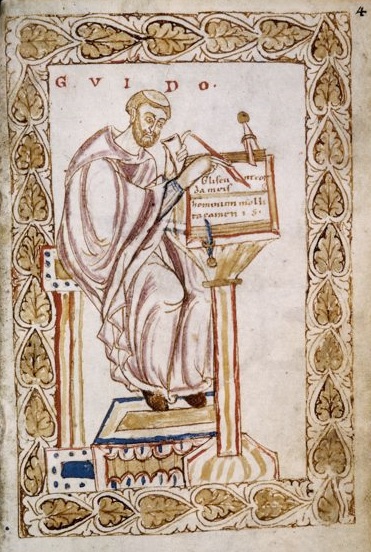Table of Contents
Introduction
In this article we will answer in the most practical and concise way possible to the question Who invented musical notes? through a historical synthesis of the main events and protagonists of the story. In particular, we will focus on the birth of note names.

Who Invented Musical Notes?
The inventor of the name of the musical notes was the Christian monk Guido D’Arezzo (992?-1050), also called Guido Monaco or Guido Pomposiano. A great music theorist, almost all of his works had a pedagogical purpose. But his invention did not come from nowhere: let’s retrace its history in a nutshell.
Who Invented Musical Notes? The IX Century
In the ninth century music was written mostly using the so-called neumi, or signs that according to the musicologist Gregorio Maria Suñol had been derived directly from classical grammatical accents, in particular Latin and Greek. These signs did not accurately indicate the height of the notes, but only gave relative indications. However, towards the end of the century, mainly because of the difficulties of transmitting the Gregorian repertoire, it began to try to elaborate a type of notation that would allow to precisely define the acoustic frequencies.
Who Invented Musical Notes? The X Century
In the tenth century, a very distant ancestor of the pentagram began to be adopted, a system of colored lines indicating respectively the fa (red) and the C (yellow). Since next to this type of lines were indicated, above or below, only notes close to the semitone, probably this first systematization favored the development of the diatonic conception of music, where by diatonic scale we mean the one in which the octave is divided into five tones and two semitones (for a total of twelve semitones). This structure, at the base of the system we still use today, was not at all common in the tenth century, in which intervals smaller than the semitone were probably still used. The new writing system forced to adapt to the new conventions, and prepared the ground for the discoveries of the following century.
Who Invented Musical Notes? The XI Century
Let’s finally try to answer more fully the question Who invented musical notes? Although even in the eleventh century we record the use of colored lines, with Guido D’Arezzo was finally fixed a system of four musical lines, called tetragrammaton, which was accompanied by the two keys of C and fa. Practically a clear ancestor of our double pentagram, which we talked about in an article that you can find here.
Who Invented Musical Notes? The XII Century
But Guidonian notation did not immediately become a common convention. If Guido D’Arezzo had started a real revolution, at the end of the twelfth century notations in square form began to assert themselves that put a point to many legacies of the notation for neumes, in positive and negative: let’s think for example of how much expressive richness in neumatic notation is not reflected in the next one. Meanwhile, the ancient writing for neumes was still used, albeit in a very simplified form: think for example of the Aquitanian notation, typical of southern France. That is why the answer to the question Who invented musical notes? it is not at all obvious, and to give it it is necessary to understand a long process of secular maturation that took place under the impulse of Guido D’Arezzo.
Who Was Guido D’Arezzo?
We know very little about the life of this great Christian scholar and monk: just think that his date of birth and death has not yet been clearly fixed, and that many scholars are uncertain as to whether or not he was born in Talla, in the province of Arezzo. We know that he worked the great didactic innovation of which we have traced, in a nutshell, the salient features. He certainly moved later to Arezzo, after having carried out a pedagogical research that had seen him engaged in Pomposa. In Arezzo the bishop Teodaldo di Canossa took him under his protection, and allowed him to continue his work. We also know that in 1032 his work received the approval of Pope John XIX. Having become a hermit, he died according to some manuals of Storia Della Musica, including Vaccarone-Poli-Iovino, in 1050. According to other sources, the date of death would be to be defined, without any certain date, approximately beyond 1033.
The Invention Of Notes Names
The names of the notes are one of the most important parts of music teaching since they make up today’s Scala Fondamentale, a phrase introduced in the Piano Reading Method manual and which we have also talked about in depth in an article that you can find here. Five of these names came directly from Guidonian notation: re, mi, fa, sol e la. As you can see in the video I left you below, these names were taken from a hymn to St. John the Baptist, presumably created for the purpose, in which the emistichi, or the halves of the verse separated by caesura, begin precisely with the names indicated by Guido D’Arezzo. Our do corresponded to the ut you see in the hymn below.
If you want to deepen the musical analysis and reading of music, as well as your compositional skills, do not forget that there is our individual online course dedicated to this: you can find the course program in the online courses section > course program, or book an individual lesson online by consulting the availability calendar directly here.
Bartolomé Ramos de Pareja
The si was not part of the Guidonian idea, and was introduced by the mathematician, composer and music theorist Bartolomé Ramos de Pareja (1440-1522) who used the initials of the words Sancte Johannes with which the hymn ends.
Giovanni Battista Doni
The music theorist Giovanni Battista Doni (1594-1647) used the first syllable of his surname to make the name of note ut more cantabile, with the introduction of the vowel at the end of the syllable (a characteristic that unites it to the other notable names).
Conclusions
For this article on who invented musical notes is everything. Do not forget to subscribe to the email form so as not to miss the news related to the topic: we are going to analyze in detail the scores mentioned talking about various compositional forms in the section on Musical Analysis. See you in the next article!
- History Of The Piano – The Fortepiano - July 12, 2022
- Curt Sachs – History Of Organology At a Glance - July 8, 2022
- Giuseppe Verdi – Rigoletto, Il Trovatore, La Traviata - June 29, 2022
